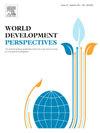How much of economic growth trickles down to the population in resource-rich countries? evidence from Papua New Guinea
IF 2.3
Q2 DEVELOPMENT STUDIES
引用次数: 0
Abstract
There has been substantial growth in the resource sector in PNG during the last resource boom and significant increases in international assistance, both of which might have translated into improved well-being outcomes across the country. To better understand whether these changes improved household-level outcomes, we update estimates of key well-being outcomes in the country. Specifically, we impute monetary poverty status using non-monetary indicators in the 2016–18 Demographic and Health Survey and estimate the World Bank’s Multidimensional Poverty Measure. Despite the significant growth since 2009, monetary poverty and access to several essential services hardly changed, which stands in stark contrast to the substantial improvement across the rest of the world and other comparison regions over the same period. Combined, the results illustrate that it is possible that very little resource-led growth trickles down to the population and that the link between macroeconomic and microeconomic outcomes is more tenuous in PNG than found in other resource-intensive settings.
在资源丰富的国家,有多少经济增长惠及了人口?证据来自巴布亚新几内亚
在上一次资源繁荣期间,巴布亚新几内亚的资源部门出现了大幅增长,国际援助也大幅增加,这两者都可能转化为全国福祉的改善。为了更好地了解这些变化是否改善了家庭层面的结果,我们更新了对该国主要福祉结果的估计。具体而言,我们使用2016-18年人口与健康调查中的非货币指标估算货币贫困状况,并估计世界银行的多维贫困措施。尽管自2009年以来增长显著,但货币贫困和几种基本服务的可及性几乎没有改变,这与同期世界其他地区和其他比较地区的大幅改善形成鲜明对比。综上所述,研究结果表明,与其他资源密集型国家相比,巴布亚新几内亚的宏观经济和微观经济结果之间的联系可能更加薄弱。
本文章由计算机程序翻译,如有差异,请以英文原文为准。
求助全文
约1分钟内获得全文
求助全文
来源期刊

World Development Perspectives
Social Sciences-Sociology and Political Science
CiteScore
4.50
自引率
0.00%
发文量
65
审稿时长
84 days
期刊介绍:
World Development Perspectives is a multi-disciplinary journal of international development. It seeks to explore ways of improving human well-being by examining the performance and impact of interventions designed to address issues related to: poverty alleviation, public health and malnutrition, agricultural production, natural resource governance, globalization and transnational processes, technological progress, gender and social discrimination, and participation in economic and political life. Above all, we are particularly interested in the role of historical, legal, social, economic, political, biophysical, and/or ecological contexts in shaping development processes and outcomes.
 求助内容:
求助内容: 应助结果提醒方式:
应助结果提醒方式:


